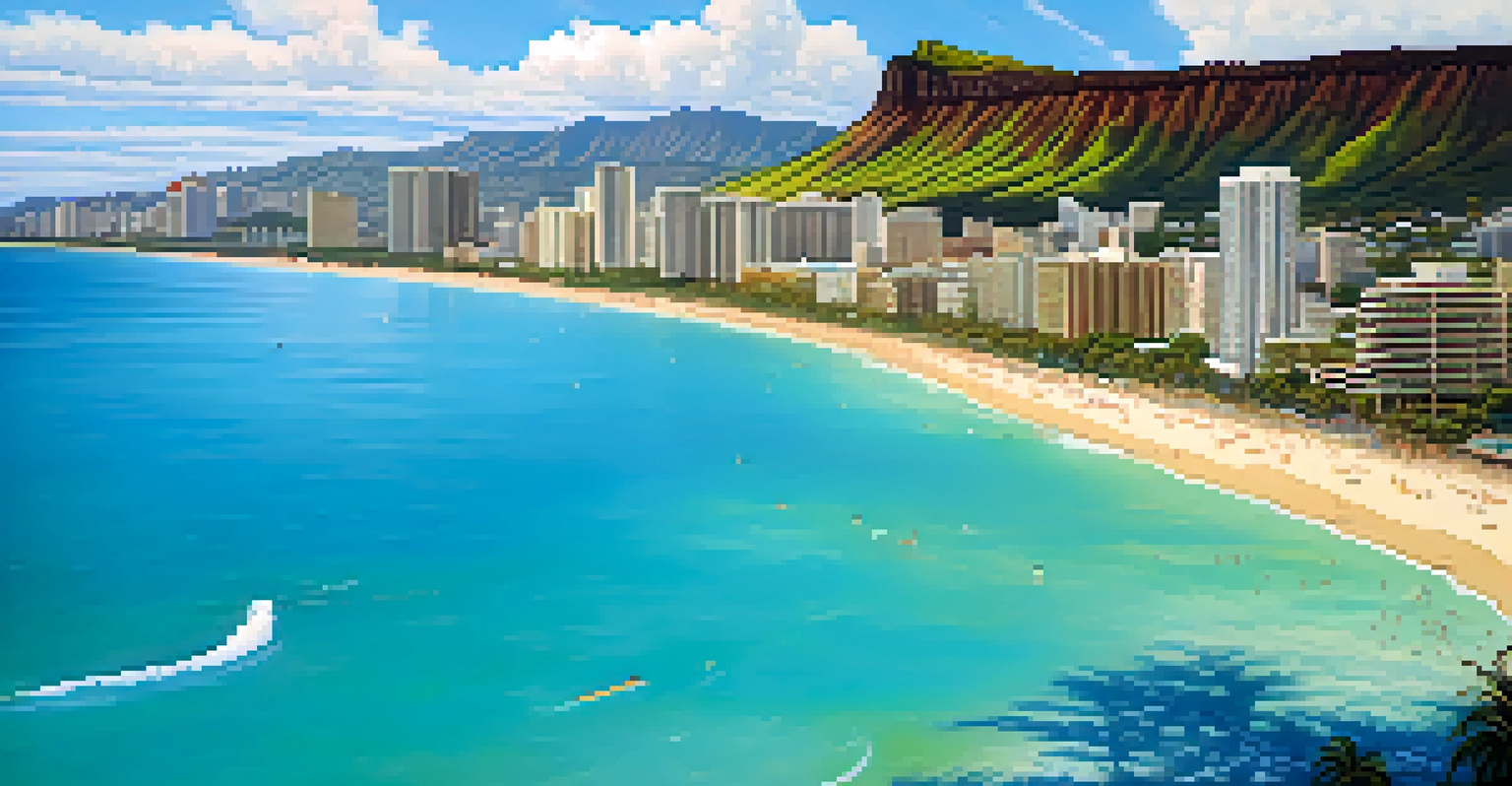Hawaii's Climate Patterns: A Guide to Tropical Weather Trends

An Overview of Hawaii's Unique Tropical Climate
Hawaii's climate is often described as a tropical paradise, but it’s more complex than just sunshine and surf. The islands experience two main seasons: a dry season from May to October and a wetter season from November to April. Each island has its own microclimates, influenced by elevation, trade winds, and surrounding ocean currents, making Hawaii a fascinating study in climate variability.
Climate change knows no borders. It is a global problem that requires global solutions.
For example, the lush windward sides of the islands, like Hilo on the Big Island, receive abundant rainfall, while the leeward sides, such as Waikiki, tend to be much drier. This diversity creates not only stunning landscapes but also unique ecosystems that thrive in their respective environments. Understanding these climate nuances is key for both residents and visitors, especially when planning outdoor activities.
In essence, Hawaii’s tropical climate is shaped by its geography and weather patterns, offering a little something for everyone. Whether you’re hiking in the rainforest or relaxing on a beach, being aware of the climate can enhance your experience and help you make the most of your time in this beautiful region.
The Role of Trade Winds in Hawaii's Weather
Trade winds are a defining feature of Hawaii's weather, blowing from the northeast and greatly influencing the islands' climate. These winds not only moderate temperatures but also bring moisture from the ocean, leading to regular rainfall on the windward sides of the islands. This consistent weather pattern helps maintain the islands' lush vegetation and vibrant ecosystems.

Interestingly, the strength and direction of the trade winds can shift, particularly during the summer months. When these winds weaken, it can lead to warmer temperatures and increased humidity, which might make for a less comfortable stay if you're not used to the tropical heat. Understanding how these winds work can help travelers prepare for the varying conditions throughout the year.
Hawaii's Climate is Diverse
Hawaii experiences unique microclimates influenced by elevation and trade winds, creating varied weather conditions across the islands.
In summary, trade winds are vital for maintaining Hawaii's unique weather patterns, affecting everything from daily temperatures to rainfall distribution. Being mindful of these winds can help you plan better for outdoor adventures and appreciate the natural beauty that they help create.
Rainfall Patterns Across the Hawaiian Islands
Hawaii's rainfall patterns can vary dramatically from one side of an island to another, making it crucial to understand where and when to expect rain. The windward sides generally receive more precipitation, while the leeward sides tend to have drier weather. For instance, the town of Waimea on the Big Island is known for its dry climate, while the nearby Hilo area is one of the wettest places on Earth.
In Hawaii, we have an obligation to protect and preserve the land, the water, and the air for future generations.
These rainfall variations not only shape the landscape but also impact local agriculture and water supply. Farmers often rely on the predictable wet and dry seasons to cultivate crops, while residents adapt their lifestyles to accommodate the weather. This reliance on rainfall patterns can also affect tourism, as certain activities are best enjoyed under sunny skies.
Understanding these patterns can enhance your travel experience, allowing you to choose the best times and locations for your activities. Whether you're hiking in a rainforest or spending a day at the beach, knowing where the rain is likely to fall can help you make the most of your time in Hawaii.
Seasonal Changes and Their Impact on Climate
Hawaii experiences two main seasons: the dry season and the wet season, each bringing its own set of weather patterns. The dry season, which runs from May to October, typically features warm temperatures and lower humidity, making it a popular time for tourists. Conversely, the wet season from November to April sees increased rainfall, cooler temperatures, and occasional storms, which can change the landscape dramatically.
During the wet season, the islands can experience heavy rains and even tropical storms, which can impact travel plans and outdoor activities. However, this season also brings vibrant greenery and stunning waterfalls, showcasing Hawaii's natural beauty at its finest. Local residents often look forward to the changes in seasons, as each brings its own charm and opportunities.
Trade Winds Shape Weather Patterns
The northeast trade winds play a crucial role in regulating temperatures and rainfall, particularly affecting the lush windward and drier leeward sides of the islands.
In short, being mindful of seasonal changes can enhance your travel experience in Hawaii. Knowing what to expect during your visit allows you to plan activities that suit the weather, ensuring a memorable and enjoyable stay.
Effects of El Niño and La Niña on Hawaii's Climate
El Niño and La Niña are climate phenomena that can significantly impact Hawaii's weather patterns. El Niño often leads to drier conditions and warmer temperatures in Hawaii, while La Niña typically brings wetter and cooler weather. These shifts can affect not just the daily weather but also long-term climate trends, influencing everything from agriculture to water resources.
For instance, during an El Niño event, residents might notice reduced rainfall, which can affect local farms and drinking water supplies. On the flip side, La Niña can lead to increased rainfall, which, while beneficial for replenishing water sources, may also lead to flooding and other weather-related challenges. Understanding these phenomena helps residents and visitors alike prepare for the unexpected.
Ultimately, the influence of El Niño and La Niña on Hawaii’s climate underscores the interconnectedness of global weather patterns. By staying informed about these phenomena, you can better anticipate changes in weather and plan accordingly, ensuring a smoother experience during your time in paradise.
Hawaii's Vulnerability to Climate Change
Like many regions around the world, Hawaii is not immune to the effects of climate change, which poses significant challenges to its unique ecosystem and climate patterns. Rising sea levels threaten coastal areas, while changing weather patterns can impact agriculture, tourism, and local wildlife. These issues are becoming increasingly important for residents and policymakers as they navigate future planning.
For example, coastal erosion due to rising sea levels could affect popular beaches and habitats for marine life, while altered rainfall patterns may disrupt the delicate balance of Hawaii’s ecosystems. Additionally, the tourism industry, a vital part of Hawaii's economy, may face challenges if extreme weather events become more frequent. Awareness and proactive measures are crucial to mitigating these effects.
Climate Change Threatens Hawaii
Rising sea levels and altered weather patterns due to climate change pose significant risks to Hawaii's ecosystems and tourism industry.
In summary, understanding Hawaii's vulnerability to climate change is essential for both locals and visitors. By recognizing these challenges, we can all contribute to efforts aimed at preserving the islands’ natural beauty and ensuring a sustainable future for generations to come.
Planning Your Visit Around Hawaii's Climate
When planning a trip to Hawaii, it's essential to consider the islands' diverse climate patterns to make the most of your experience. Each season offers unique opportunities, from the lush landscapes of the wet season to the sunny beaches of the dry season. Understanding these patterns can help you choose the right time to visit based on your interests and activities.
For example, if you're looking to enjoy outdoor adventures like hiking or snorkeling, visiting during the dry season can provide you with the best weather conditions. Conversely, if you’re interested in experiencing the vibrant flora and fauna that thrive during the wet season, then planning your visit between November and April might be ideal. Always keep an eye on local weather forecasts to stay informed about any changes.

Ultimately, being proactive in planning your visit can enhance your enjoyment of Hawaii’s natural beauty. By aligning your travel plans with the islands' climate patterns, you'll create lasting memories while experiencing all that this tropical paradise has to offer.